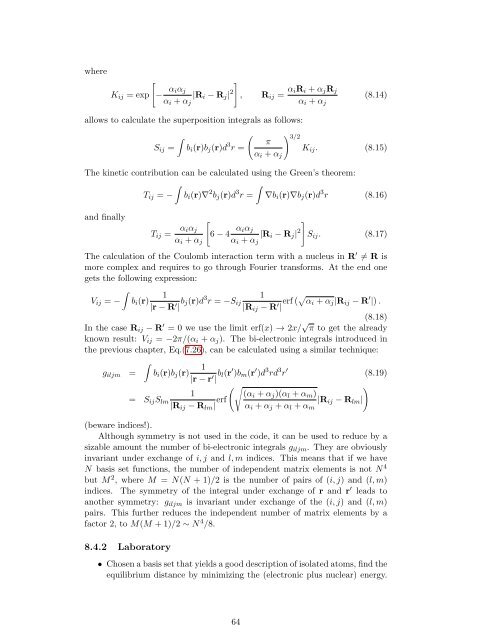Numerical Methods in Quantum Mechanics - Dipartimento di Fisica
Numerical Methods in Quantum Mechanics - Dipartimento di Fisica
Numerical Methods in Quantum Mechanics - Dipartimento di Fisica
You also want an ePaper? Increase the reach of your titles
YUMPU automatically turns print PDFs into web optimized ePapers that Google loves.
where<br />
K ij = exp<br />
[<br />
− α iα j<br />
α i + α j<br />
|R i − R j | 2 ]<br />
, R ij = α iR i + α j R j<br />
α i + α j<br />
(8.14)<br />
allows to calculate the superposition <strong>in</strong>tegrals as follows:<br />
∫<br />
S ij =<br />
b i (r)b j (r)d 3 r =<br />
(<br />
π<br />
α i + α j<br />
) 3/2<br />
K ij . (8.15)<br />
The k<strong>in</strong>etic contribution can be calculated us<strong>in</strong>g the Green’s theorem:<br />
∫<br />
∫<br />
T ij = − b i (r)∇ 2 b j (r)d 3 r = ∇b i (r)∇b j (r)d 3 r (8.16)<br />
and f<strong>in</strong>ally<br />
T ij =<br />
α [<br />
iα j<br />
6 − 4 α ]<br />
iα j<br />
|R i − R j | 2 S ij . (8.17)<br />
α i + α j α i + α j<br />
The calculation of the Coulomb <strong>in</strong>teraction term with a nucleus <strong>in</strong> R ′ ≠ R is<br />
more complex and requires to go through Fourier transforms. At the end one<br />
gets the follow<strong>in</strong>g expression:<br />
∫<br />
1<br />
V ij = − b i (r)<br />
|r − R ′ | b j(r)d 3 1<br />
r = −S ij<br />
|R ij − R ′ | erf (√ α i + α j |R ij − R ′ | ) .<br />
(8.18)<br />
In the case R ij − R ′ = 0 we use the limit erf(x) → 2x/ √ π to get the already<br />
known result: V ij = −2π/(α i + α j ). The bi-electronic <strong>in</strong>tegrals <strong>in</strong>troduced <strong>in</strong><br />
the previous chapter, Eq.(7.26), can be calculated us<strong>in</strong>g a similar technique:<br />
g iljm =<br />
∫<br />
1<br />
b i (r)b j (r)<br />
|r − r ′ | b l(r ′ )b m (r ′ )d 3 rd 3 r ′ (8.19)<br />
= S ij S lm<br />
1<br />
|R ij − R lm | erf (√<br />
(αi + α j )(α l + α m )<br />
α i + α j + α l + α m<br />
|R ij − R lm |<br />
(beware <strong>in</strong><strong>di</strong>ces!).<br />
Although symmetry is not used <strong>in</strong> the code, it can be used to reduce by a<br />
sizable amount the number of bi-electronic <strong>in</strong>tegrals g iljm . They are obviously<br />
<strong>in</strong>variant under exchange of i, j and l, m <strong>in</strong><strong>di</strong>ces. This means that if we have<br />
N basis set functions, the number of <strong>in</strong>dependent matrix elements is not N 4<br />
but M 2 , where M = N(N + 1)/2 is the number of pairs of (i, j) and (l, m)<br />
<strong>in</strong><strong>di</strong>ces. The symmetry of the <strong>in</strong>tegral under exchange of r and r ′ leads to<br />
another symmetry: g iljm is <strong>in</strong>variant under exchange of the (i, j) and (l, m)<br />
pairs. This further reduces the <strong>in</strong>dependent number of matrix elements by a<br />
factor 2, to M(M + 1)/2 ∼ N 4 /8.<br />
8.4.2 Laboratory<br />
• Chosen a basis set that yields a good description of isolated atoms, f<strong>in</strong>d the<br />
equilibrium <strong>di</strong>stance by m<strong>in</strong>imiz<strong>in</strong>g the (electronic plus nuclear) energy.<br />
)<br />
64
















